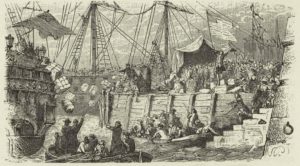Andebit et beaqui corendit, ut quostes esciendion re dit ad et prae parion es quia quas alibus sam, omnim faciden ducipidiat arum autem nobis enis es voat

3. Driving to Ausable Chasm: Shifting British Strategy
Understanding the events leading up to the Revolutionary War: The French and Indian War and the strategic importance of Lake Champlain.
Listen to the Turning Point Trail Site 3 Audio Narration:

During the 17th and 18th centuries, France and England were in full colonization mode and, it seems, at war with each other on and off since the decline of the Roman Empire in the early 13th century. As both nations grew their colonial empires around the world, they also had new battlefields to fight upon.
In North America, a series of water passages and land-carries formed a travel corridor between the British landholdings in the Hudson Valley and the French outposts along Lake Champlain and the St. Lawrence River. This waterway became the focal point for colonial warfare. It was the super-highway of the 17th and 18th centuries, allowing for easy transport of troops and supplies to the frontier battlefields of Lakes George and Champlain. Control of the waterways of Lakes to Locks Passage meant control of the continent. The Seven Years War, known as the French and Indian War in North America, was the fourth and final war before the British expelled the French from Canada.
In 1763, the British Empire spanned the globe, but it was already showing signs of fracture. Warfare had left the king with a depleted treasury, while the colonists in America were enjoying greater liberties and fewer taxes than in England. Many people in England believed that the colonists should pay their fair share of taxes. However, many colonists believed that they were already giving the king plenty–and it was not within his rights to tax them without representation in the House of Commons.
Today, tossing tea in Boston Harbor may seem like a fairly harmless act, but on a cold December day in 1773, it was one of a series of attacks against the authority of King George III of Great Britain. It was His Majesty’s desire that the Province of Massachusetts Bay be dismantled–its charter revoked and its provincial government dissolved. Many colonists resisted. Attempts to suppress the “Bostonian” Rebels in 1775 failed when the Massachusetts Militia was reinforced by the newly formed Continental Army. The king decided swift and forceful action was needed to prevent the rebellion from spreading.
In 1776, the British shifted their strategy. They decided to seize control of the strategically significant Hudson River/Lake Champlain waterway. Success there would cut off New England–the seedbed of the revolution–from the rest of the colonies and isolate the rebellion. Although the British had secured their position in Quebec and captured New York City, they were not able to gain control of the connecting waterway.
In 1777, the British renewed their efforts by dispatching British General John Burgoyne to secure control of Lake Champlain, Lake George, and the Hudson River to Albany. They believed he was the man with the fire and the ambition to get the job done.
Travel Tools
Start track 3 as soon as you leave the Peru Dock Boat Launch. Enjoy the lake and farmland views as you drive south on Route 9 to Ausable Chasm.
CLICK TO ADVANCE PAGE TO SITE FOUR


